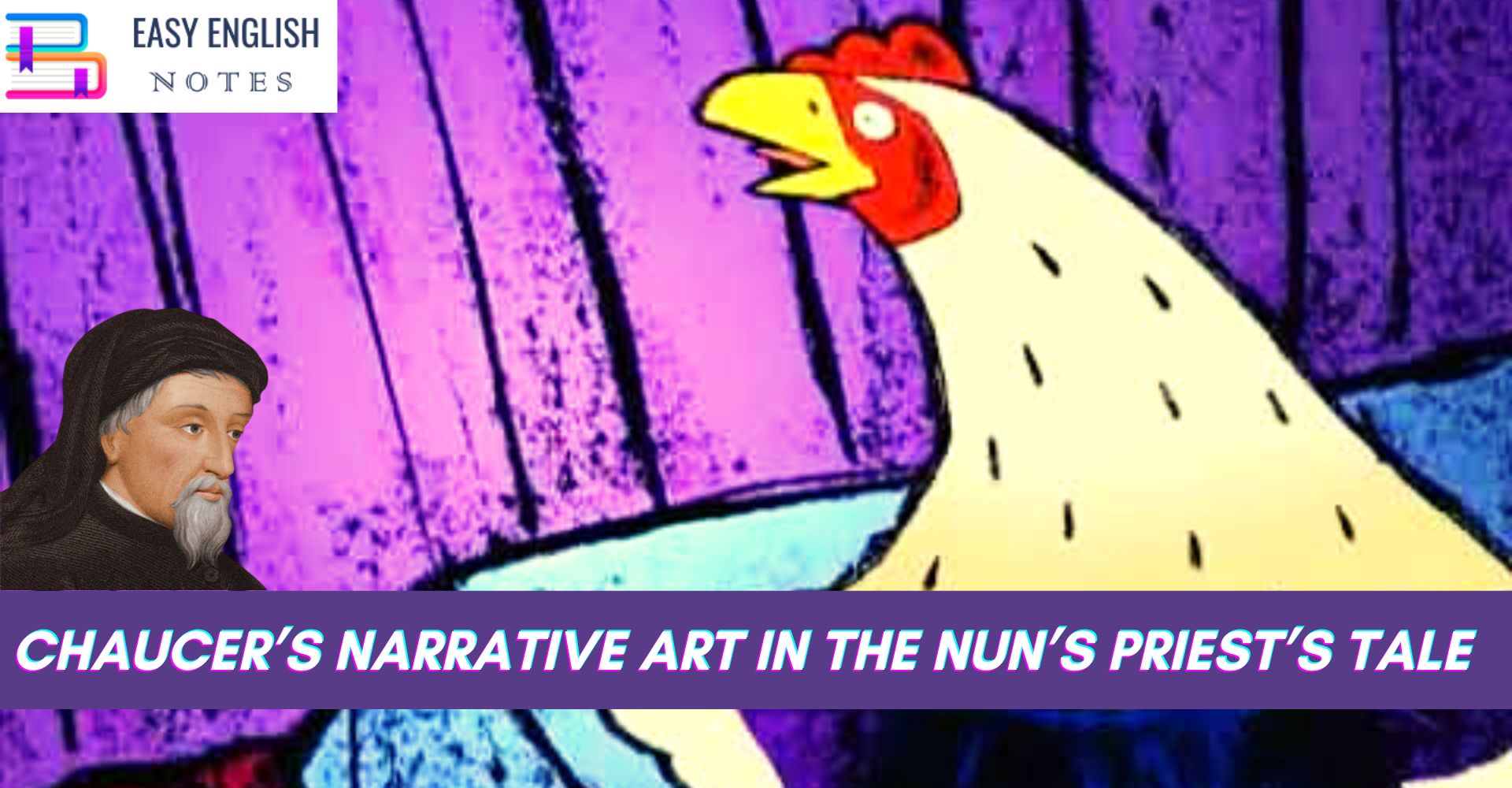Geoffrey Chaucer in The Nun’s Priest’s Tale has shown his ability to develop a skeleton plot into a good story. As a teller of tales in verse he has been rightly compared with Burn. He has a distinct style of narration. His art of characterisation, observation and description. His ability to build a background, his dramatic and fictional bent, his rich imagination and humour make his narration very palatable and delightful.
In The Nun’s Priest’s Tale, we see Chaucer’s narrative skill in the manner in which he handles the mock-heroic technique in this poem. The mock-heroic effect is produced by the application of elevated language to a trivial subject. The language. Descriptions and dialogues, the similes and lofty exclamations are sustained at an exalted level throughout the poem, and yet we are never allowed to lose sight of the joke, so that our recognition of the grand style of the poem as being mock serious in intention never falters.
Chaucer heightens the dramatic effect by giving a description of the dreams first. There is very little action in the story, hence the speed of narration is very slow. The opening description of the widow’s frugal way of life illustrates this well. After being told that she was poor and led a life of simplicity, we are given an elaborate account of the delicacies which she did not consume and of the ailments which, as a result, she did not suffer from. At the same time, as setting the leisurely pace of the narrative, this opining makes several points which re-cur later and which we then recall with pleasant recognition. Such glancing forward and backward is a characteristic feature of Chaucer’s narrative art. The widow’s “sooty hall” is also Chanticleer’s court. The “repletion” from which the widow does not suffer gets a prominent place in Pertelote’s list of ailments which cause bad dreams. And the widow’s occasional eating an egg or two serves as an appropriate beginning to the introduction of the cock and the hens.
It Is towards the end of the story that the narrative gathers speed. But still the narrator’s delaying tactics continue, punctuated by promises to get on with his story: “Now wol I tome agayn to my sentence.” The fox is introduced and soon he seizes the cock. After a few apostrophes, the pursuit begins; and from this moment onwards the rapid movement of the chase continues till the end. The contrast between a large portion of the poem and the final seventy lines is a sharp and effective one. We can see how it is achieved by contrasting the one brief aside concerning Fortune with the several earlier and much longer interruptions; or by comparing the final brief. Quick exchanges between cock and fox with the long and elaborate speeches which have gone before.
An analysis of the poem shows that by far the greater part of the story deals not with the fable. But with dreams. After we have been introduced to the poor widow’s household and to the cock and the hen, the cock’s dream is related and discussed at such length and with such a show of learning that it inevitably becomes the central point of interest in the story.
The end of the narrative Is marvellous. The last two hundred lines of the story are a splendid example of Chaucer’s narrative skill. When the end of the story comes we are back in the poor widow’s yard and the nearby grove, and now the movement is swift and uninterrupted as the old beast-fable is allowed to take its familiar course.
Just as the fall of the hero of an epic shakes the whole of society. So the fall of Chanticleer produces a tumult in the farmyard. The pursuit of the fox is a superb crowded scene. Described with great zest. Chaucer brings into the picture of the up widow, her two daughters, the dogs, the goat, the cow and her calf, ducks, geese, a swarm of bees, and “the verray hogges”. The confusion and noise reach a climax with the trumpets until it seems that the heavens will fall. Much of the poem is taken with discussion and debate. To which this sudden eruption into action makes a contrasting climax.
As a narrative poet, Chaucer makes use of what were known in the Middle Ages as the colours of rhetoric. The basic idea of medieval rhetoric was to “amplify” the poem, or to elaborate it. The opening of the present poem, which has been examined above. Is a good example of one type of “amplification”. In this case, to express a simple idea in an elaborate manner. The poor widow’s modest household and frugal way of life are the opening theme of the story. Chaucer amplifies this into twenty- five lines (and in doing so he adds the several touches already mentioned and sets also the leisurely pace of most of the priest’s narrative).
Chaucer’s method is to employ a combination of positive and negative statements. Some of the opening lines create their impression by the choice and skillful distribution of three groups of highly suggestive words. The poet uses similes which embellish the charm of the narrative. The test of a successful narrative is its capacity to grip the readers’ attention. The Nun’s Priest’s Tale passes the test. Even though the ending of the story may already be known, the author manages to produce suspense. The narrative is further enriched by vivid characterization, an abundance of humour, skillful moralizing, a wealth of allusion and reference, brief reflective and philosophical passages, and the “colours of rhetoric”. The fact that the story is told at two levels the animal and the human- enhances its interest greatly.
PLEASE HELP ME TO REACH 1000 SUBSCRIBER ON MY COOKING YT CHANNEL (CLICK HERE)











